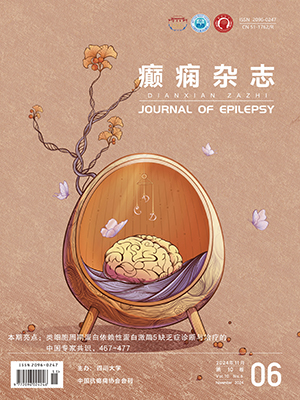| 1. |
中国抗癫痫协会. 临床诊疗指南•癫痫病分册. 人民卫生出版社, 2023: 6.
|
| 2. |
Ding D, Zhou D, Sander JW, et al. Epilepsy in China: major progress in the past two decades. Lancet Neurol, 2021, 20(4): 316-326.
|
| 3. |
Liu W, Xu Y, Lin Y, et al. Burden of epilepsy in China and its provinces, 1990 to 2019: findings from the Global Burden of Disease Study 2019. Chin Med J (Engl), 2023, 136(3): 305-312.
|
| 4. |
中华医学会神经病学分会, 中华医学会神经病学分会脑电图与癫痫学组. 抗癫痫发作药物联合使用中国专家共识. 中华神经科杂志, 2024, 57(2): 108-117.
|
| 5. |
陈玉秀, 连雨晴, 赵玉华. 高原地区癫痫相关研究进展. 中国神经精神疾病杂志, 2023, 49(12): 744-747.
|
| 6. |
何世华, 卓玛, 赵玉华, 等. 西藏地区发作性疾病的分类及癫痫发作的相关研究. 癫痫杂志, 2020, 6(3): 210-214.
|
| 7. |
Zhao Y, Zhang Q, Tsering T, et al. Prevalence of convulsive epilepsy and health-related quality of life of the population with convulsive epilepsy in rural areas of Tibet Autonomous Region in China: an initial survey. Epilepsy Behav, 2008, 12(3): 373-381.
|
| 8. |
Goel D, Aggarwal P, Kandpal SD, et al. Epidemiology of new onset seizures and epilepsy cases: a prospective cohort study. Seizure, 2020, 6(1): 30-37.
|
| 9. |
张凯月, 郑昭时, 王涵, 等. 吡仑帕奈治疗成人癫痫的临床实践. 癫痫杂志, 2023, 9(5): 369-374.
|
| 10. |
张一. 滇西地区癫痫患者病因分析. 大理大学, 硕士学位论文, 2023: 9-20.
|
| 11. |
Feyissa AM, Hasan TF, Meschia JF. Stroke-related epilepsy. Eur J Neurol, 2019, 26(1): 13-18.
|
| 12. |
次央, 胡亚雄, 王其琪, 等. 高原地区卒中后癫痫的临床及预后特征. 中国卒中杂志, 2024, 19(4): 423-430.
|
| 13. |
Chen J, Wu X, He Y, et al. A retrospective analysis of the clinical features of inpatients with epilepsy in the Ganzi Tibetan Autonomous Prefecture. Front Neurol, 2018, 9: 891.
|
| 14. |
王薇薇, 吴逊. 癫痫诊断延迟的原因及后果. 中风与神经疾病杂志, 2024, 41(6): 483-485.
|
| 15. |
Kanner AM, Bicchi MM. Antiseizure medications for adults with epilepsy: a review. JAMA, 2022, 327(13): 1269-1281.
|
| 16. |
Dwajani S, Adarsh E, Nirmala KS, et al. Sociodemographic, rationale drug use of antiepileptic drugs among pediatric patients with epilepsy: a prospective study at a tertiary care hospital. J Neurosci Rural Pract, 2019, 10(3): 474-478.
|
| 17. |
郑淼磊, 黄倩. 联合用药治疗青年难治性癫痫的疗效分析. 深圳中西医结合杂志, 2019, 29(7): 96-97.
|
| 18. |
朱翠, 张冉冉, 杨婷婷, 等. 抗痫性发作药物联合治疗成人难治性癫痫疗效及安全性的真实世界研究. 癫痫与神经电生理学杂志, 2022, 31(2): 76-82.
|
| 19. |
李琳, 张慧娟, 王文霞. 左乙拉西坦联合丙戊酸钠治疗小儿癫痫的临床效果. 临床医学研究与实践, 2023, 8(5): 89-91.
|
| 20. |
李巧艳, 刘明周, 孙俊, 等. 基于治疗药物监测的癫痫患者不规范用药现象分析和病例报道. 中国合理用药探索, 2021, 18(9): 39-43.
|
| 21. |
刘琛俐, 廖祥萍, 刘南海. 难治性癫痫的诊治进展. 世界最新医学信息文摘, 2019, 19(99): 129-130.
|
| 22. |
Chen Z, Brodie MJ, Liew D, et al. Treatment outcomes in patients with newly diagnosed epilepsy treated with established and new antiepileptic drugs: a 30-year longitudinal cohort study. JAMA Neurol, 2018, 75(3): 279-286.
|
| 23. |
Janmohamed M, Brodie MJ, Kwan P. Pharmacoresistance-Epidemiology, mechanisms, and impact on epilepsy treatment. Neuropharmacology, 2020, 168: 107790.
|
| 24. |
Perucca E, Brodie MJ, Kwan P, et al. 30 years of second-generation antiseizure medications: impact and future perspectives. Lancet Neurol, 2020, 19(6): 544-556.
|
| 25. |
薛楚鹏, 李承燕, 刘玲, 等. 难治性癫痫的遗传学病因研究进展. 广东医科大学学报, 2023, 41(4): 455-459.
|




